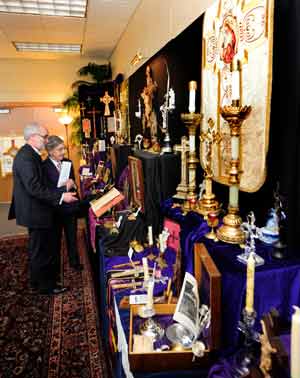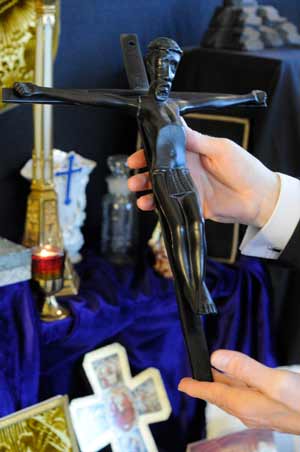 Ginny De Battista and Fr. Kenneth Augustine look over a collection of crosses that Fr. Augustine and his mother, Helen C. Augustine, have accumulated over the years, at St. Luke in Brookfield on Sunday, March 27. (Catholic Herald photo by Ernie Mastoianni)BROOKFIELD – A familiar hymn urges believers to “lift high the cross,” and at St. Luke Catholic Church, a special Lenten exhibit did just that.
Ginny De Battista and Fr. Kenneth Augustine look over a collection of crosses that Fr. Augustine and his mother, Helen C. Augustine, have accumulated over the years, at St. Luke in Brookfield on Sunday, March 27. (Catholic Herald photo by Ernie Mastoianni)BROOKFIELD – A familiar hymn urges believers to “lift high the cross,” and at St. Luke Catholic Church, a special Lenten exhibit did just that.
The church’s pastor, Fr. Kenneth J. Augustine, shared his and his mother’s personal collection of more than 150 crosses, crucifixes and related objects. The items included crosses and crucifixes of many sizes, along with statues, rosaries, sick call sets, missals, altar cloths, holy water fonts, monstrances, vestments and even a small music box shaped like a pulpit. The items ringed the walls of the parish’s narthex meeting room, beneath, appropriately, windows depicting the Stations of the Cross.
Hundreds of parishioners, including St. Luke’s confirmation class, viewed the exhibit, which was open for three weekends. Kneelers and chairs were available for those who wished to pray or spend time discussing the exhibit.
“When I saw this, I didn’t just see crosses,” said longtime parishioner Laura Baird, who viewed the display with her husband, Robert. “It was the message of God sending his son Jesus to die on the cross for us because of his deep love for us.
“A cross doesn’t have to be extravagant. It’s more the meaning of it than the material quality of it.”
Fr. Augustine said he hoped those who saw the exhibit would experience “how all-inclusive the sign is.” Indeed, the crucifixes portray Christ in a variety of ways, and the objects are made from materials ranging from many types of wood and metal to ivory, ceramic and brightly-colored fabrics.
One piece that has special meaning to Fr. Augustine is an African-style crucifix carved from ebony.
“Christ is all of us,” said Fr. Augustine. “It is a broadness we all need today.”
 One of Fr. Kenneth Augustine’s favorite crosses in his collection is this African corpus cross that he bought at the thrift shop at St. Mary Visitation Parish, Elm Grove. It was one of the hundreds on display at St. Luke Church in Brookfield on Sunday, March 27. (Catholic Herald photo by Ernie Mastoianni)Another piece he especially likes is a cross made of Honduran mahogany. The Christ figure is hollowed from the cross itself.
One of Fr. Kenneth Augustine’s favorite crosses in his collection is this African corpus cross that he bought at the thrift shop at St. Mary Visitation Parish, Elm Grove. It was one of the hundreds on display at St. Luke Church in Brookfield on Sunday, March 27. (Catholic Herald photo by Ernie Mastoianni)Another piece he especially likes is a cross made of Honduran mahogany. The Christ figure is hollowed from the cross itself.
“The cutout shows that we are the Christ, which is a beautiful reminder to us all,” said Fr. Augustine.
The cross as a symbol predates Christianity, Fr. Augustine noted. It is found in many ancient cultures, including Greek, Egyptian and Hebrew.
“The intersection of two lines has spoken of the connection between heaven and earth, the godly/divine and the human,” said Fr. Augustine. “In Christianity, to me at least, it speaks of facing our humanness head-on as Jesus did, speaking the truth and being willing to die for it.”
St. Francis of Assisi is credited with promoting the corpus, or representation of the dying Christ, on crosses. Francis also is well known for popularizing portrayals of the Nativity early in the 13th century.
At home, Fr. Augustine has displayed a crèche year-round at the foot of one of his favorite crucifixes as a reminder that “Christmas and Easter are one mystery – the incarnation, and the fullness and depth of love,” he explained.
Fr. Augustine began his collection long before his ordination in 1977. His interest was sparked by his mother, Helen, who lives in Oconto. One of his early acquisitions was a piece of a vestment; it hung on his wall when he was a high school seminary student in Oneida.
His grandmother gave him a crucifix similar to those he had seen on rosaries used by nuns – she called them “happy death” crucifixes. In the same vein, Fr. Augustine owns a print of a dying man holding a cross as last rites are being administered. Also at the man’s bedside are his family and several angels.
Over the years, Fr. Augustine has received crosses as gifts, but he’s also purchased many. He’s an avid shopper at second-hand stores – he found the African-style crucifix at the St. Mary’s Visitation Thrift Shop in Elm Grove. One resale shop yielded a photo, perhaps 100 years old, of a boy posing next to a crucifix-adorned “crucicandle” (candlestick) just like one Fr. Augustine owns.
At a Goodwill Store, he picked up a framed calligraphy saying: “Each one of us who travels further than the obstacles will know a different kind of life from that time on.” He said the quote is a reminder of “the journey of crossing.”
Religious items at resale stores probably come largely from people who are cleaning out an older relative’s house and reflect more than just a difference in decorating styles, Fr. Augustine said.
“I would guess many times the upcoming generations don’t have the same religious affiliation, attraction or beliefs,” he said. “(Crosses and crucifixes) don’t seem to be as essential today in many people’s lives.”
Fr. Augustine likes retired Auxiliary Bishop Richard J. Sklba’s suggestion to candidates and catechumens at the Rite of Election – “be good to yourself and go out and purchase one good piece of Christian art for your home.” It’s good advice for any Catholic, Fr. Augustine said.
“It’s really important,” he explained, “because we’re being bombarded with all kinds of other things today, but how many homes actually have something that’s Christian art and part of our heritage?”
Fr. Augustine offered to create the display after St. Luke’s director of religious education, Marian Lamoreaux, told him of the theme she’d selected (“Crossing Through Faith: A Lenten Journey”) for the parish’s Ash Wednesday dinner.
“I had no idea his crosses would be like this,” she said.
The 80 people who attended the dinner learned about the history of the cross and could choose twigs and other materials to make their own crosses. A cross made that evening by parishioner Ginny De Battista is part of the display, the bookend to the oldest item in the collection – a pedestal crucifix with a delicately carved ivory corpus believed to date to the mid 1800s.
Crafting simple crosses was a meaningful activity for parishioners of all ages, Lamoreaux said.
“It was a wonderful way to bring the cross home to people,” she said. “You sure don’t look at a stick the same way again.”
